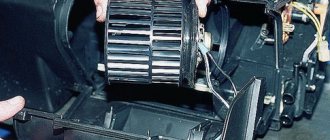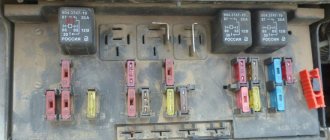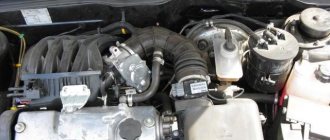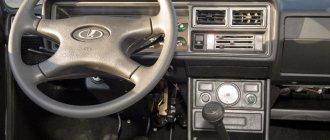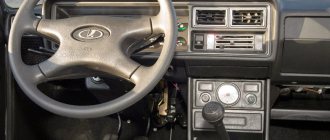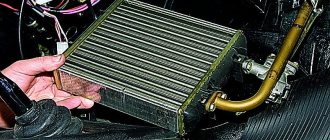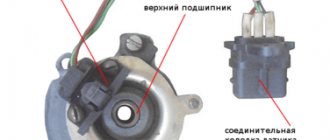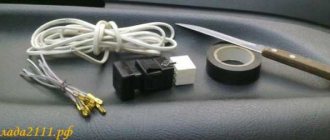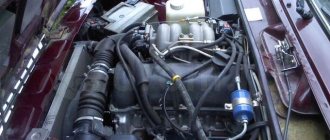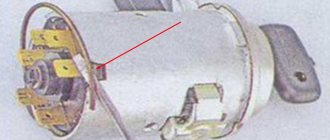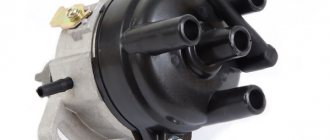And the cold is coming again. For those whose interior heater on a VAZ 2107 does not heat well, the question arises - how to make the “stove” heat better? Most 7 car owners are dissatisfied with the operation of the stove or interior heater. Indeed, the stove efficiency of the classics of this brand is very low.
But this problem can be solved by modifying the stove yourself. To improve the operation of the heater, you do not need special tools or skills; everything is done using improvised means.
Does the stove on the VAZ 2107 heat poorly?
And the cold is coming again.
For those whose interior heater on a VAZ 2107 does not heat well, the question arises - how to make the “stove” heat better? Most 7 car owners are dissatisfied with the operation of the stove or interior heater. Indeed, the stove efficiency of the classics of this brand is very low. But this problem can be solved by modifying the stove yourself. To improve the operation of the heater, you do not need special tools or skills; everything is done using improvised means.
How it works
Having studied the design of the VAZ-2107 heating system, it is easy to understand how it functions. So, the air enters the heater housing through the grilles on the hood of the car and the air supply cover. There, depending on the temperature of the coolant and the position of the heater valve valve, it warms up to a certain temperature and moves further along the air ducts through the deflectors into the cabin. The intensity of the air flow depends on the speed of the machine (with the fan turned off), or on the position of the fan mode switch. By changing the position of the lower arm of the control module, as well as the position of the lamellas in the nozzles, we direct warm air where we need it - to the windshield, to the side windows, or to the center of the cabin.
Why the stove on the VAZ 2107 does not heat well, reasons:
A common cause is an underheated engine.
Signs: The temperature gauge is in the white zone, the engine takes a long time to warm up. At an outside temperature of -20, within 8-10 minutes of idling the engine, it should warm up to 40-50 degrees (the very beginning of the white zone of the temperature gauge).
If the temperature rises less, it’s bad (the thermostat is faulty), higher is good. Next, you need to drive in 1-2 gears, and in 5-8 minutes the temperature should rise to 80 degrees (the border of the green and white zones). If the engine has not warmed up to 80, replace the thermostat!
Air in the cooling system.
First of all, you need to check the antifreeze level in the expansion tank and the serviceability of the radiator cap. If the radiator cap is faulty, air will remain in the system, which will result in poor circulation of coolant and, accordingly, cold air in the cabin.
The stove blows poorly to the left
The lower flap is completely open, or its latch is broken. To fully blow the glass, this damper must be closed. If it does not lock, you can use an elastic band, hooking it onto the “choke” handle, or somewhere else.
Air lock preventing the stove from working properly
In our article we will look at another common problem, due to which the stove begins to forcefully blow cold air into the cabin. It consists in the formation of an air lock in the system. Diagnostics usually indicate the presence of the following causes for this malfunction:
- damage to the cylinder head gasket described above;
- poor-quality connection of pipes to each other. Usually, to eliminate this malfunction, it is enough to tighten the clamps well and check the integrity of the sealing elements;
- Improper coolant replacement, which allows air to enter the system.
Modification of the VAZ 2107 stove so that it heats better.
As practice shows, the stove radiator gives off a sufficient amount of heat and its improvement is not required. This means that in order to increase the efficiency of the heater, the airflow system needs to be modified. Coat all air ducts with sealant, especially at their connections. This especially applies to VAZ 2105 - 2107 cars, due to their design features of the air ducts.
Replacing the stove motor.
The stove can be improved by installing a snail instead of an engine with an impeller, as used in VAZ 2108-2109 models. This tuning will increase air flow and reduce noise. The motor used in these models differs from the seven in its increased speed and greater power. To install it, a slight modification to the stove body will be required - due to its larger size, it is necessary to remove the comb, which directs the air flow to the feet.
You can leave the original impeller, but you need to enlarge the hole in it with a diameter of up to 7 mm, for the motor shaft from the figure eight.
Such modification of the stove also requires replacing the switch and resistor. Both parts are taken from the same model as the motor. The VAZ 2107 switch is designed for a lower current, and when used with a powerful engine it can simply melt. The native resistance of the VAZ 2107 will not allow the motor to operate at full power, which is why the resistor is changed.
We start by completely disassembling the heater housing. Almost everything is cut off from the bottom of the stove, except for the fasteners and frame. Next, we make the body for the snail. For this purpose, you can use any durable material - polycarbonate, plastic, plexiglass, etc. The four walls of the future body are cut out of the material (that you have chosen) and screwed to the bottom of the stove.
After all the steps done, we put the lower part on the middle one, first remove the diffuser. The dimensions must be adjusted so that the snail fits exactly into the body and does not protrude beyond the radiator mounts located on the middle part.
At this stage of work, you should pay special attention; if the body turns out to be large, then you will not be able to install the stove in its normal place. After accurately adjusting the dimensions of the new housing, all joints must be coated with sealant.
Let's take care of the air ducts. You can use commercially available plumbing hoses and cuffs. In the new stove body, holes of a suitable diameter for the cuffs are cut in the bottom, on both sides. Hoses are installed in them - the side ones are connected to the right and left air ducts, the lower ones away from the legs, to exhaust the warm air flow.
To heat the rear passengers, you can additionally install a pair of longer hoses. The amount of heat given off by the stove radiator and the power of the snail are quite enough for everything. The places of the side air ducts and hose connections are coated with sealant to prevent loss of warm air.
Such a modification will increase the efficiency of the stove on the VAZ 2107 by 2-3 times, both in the quality of glass blowing, a large flow of warm air does not allow the windows to fog up, and in heating the interior. This modernization of the interior heater is available to everyone and does not require large expenses.
Conversion of the VAZ-2108 stove (snail) to VAZ-2107: video
Note: it should be remembered that when installing the volute and motor, the switch must be replaced. Make sure the heater fuse has the current rating required to operate the modified heater.
Rear window heating repair
To troubleshoot the heated rear window, you should start by determining the cause of its failure. If the individual threads of the heating element do not heat up, the threads have broken somewhere.
Repair in this situation consists of restoring the electrical circuit. To do this, you can try to restore the heating circuit using a special conductive glue, or solder the disconnection point. At the gluing site, the glass will heat up more due to the greater resistance in this section of the circuit, which can lead to the glass breaking.
We recommend not doing these “things” for the sake of saving, but simply replacing the rear window with a heating element. Believe me, you will spend much more time and money, worry about soldering, and in the end, you will still come to the conclusion - buy new glass.
Option 2 - not a single heating thread (strip) heats up
Connection diagram for heated rear window of VAZ 2106
- faulty button (switch), relay, rear window heating fuse
- wires are damaged
- tips are oxidized or poorly connected
- The contact from the glass heating element has become disconnected.
Replace faulty switch, relay, fuse, wires with new ones. Clean and crimp the terminals. If the terminal is unsoldered from the heating element, replace the glass with the heating element.
First of all, you need to check the heater valve. It opens and closes with a special cable. If its tension has weakened for some reason, then when you turn the lever, the faucet either does not open at all or moves literally a few millimeters. It will need to be tightened.
It is easy to check the performance of the radiator itself by warming up the power unit while the fan is not working. All you need to do is gently touch the antifreeze supply and discharge pipes with your hand.
Often, over the summer, the heater valve manages to sour, as they say. Therefore, when an attempt is made to open it, the damper simply breaks off and the drive roller remains in place. Such an element will have to be completely replaced with a working one.
If the cooling fluid level is very low, this will cause the radiator to remain relatively cold. Here you will need to look for a leak and replenish the coolant volume.
If the thermostat breaks down, it needs to be replaced with a new one, and the air lock is removed by pumping antifreeze through the system.
A failure of any main element of the heating system should be suspected only when warm air stops flowing into the cabin altogether. If its supply is limited only in several directions, then most likely we are talking about local breakdowns.
The VAZ 2107 stove does not heat well
VAZ 2107 car does not heat up at all, the other day I went through everything down to the bolt, put everything back together as it should, the pipes going to the heater radiator are hot, even its sides are hot, and only warm air comes out.
- Why does the heater radiator burst in a VAZ 2107 - 2 answers
- The heater does not blow well into the cabin, VAZ 2107 – 6 answers
- The left glass blower from the stove does not work, VAZ 2107 - 5 answers
- The stove does not heat well - 3 answers
- Why does the windshield on one side of the VAZ 2107 not blow well? – 3 answers
The problem is very common. The fact is that in the described situation, the liquid follows the path of least resistance. The partition in the radiator tank of the VAZ 2107 stove is made of rubber and over time it dries out and moves out of its place, opening the path for liquid. It turns out that it entered the right radiator tank and immediately came out through another (outlet) pipe. Why go through the thin tubes of the radiator core, overcoming resistance, when there is such a hole. As a result, we have both hot pipes and a slightly warm middle of the radiator. It is usually treated by replacing the radiator, although if the conditions exist, you can unsolder it, put the partition in place, and the radiator will still serve for many years.
There is an option that the heater does not heat well due to the fact that the engine does not warm up completely; you can place a piece of cardboard in front of the radiator. You can also check the positions of the dampers, whose task is to regulate the “cold/hot” air supply; they may not reach the end, as a result of which cold air flows.
It seems to me that the reason is a loose fitting switch flap in the legs and in the windows (this happened to me). To check my version, lift the lever up, which is located above the gas pedal, pressing it firmly, wait a minute, holding the lever, if so, you will see the result.
We also check the movement of the control levers on the stove itself. Another reason could be the heater tap. By the way, the heater radiator could break, it cannot be repaired, it will have to be replaced, but the problems may disappear with it. If there are problems with the heater radiator, then you can read about repairing the heater radiator in the blog - The VAZ 2106 heater does not heat well.
There is also a video on the site that describes in detail possible problems with the stove, depending on the symptoms, and methods for eliminating them.
Common problems and solutions
Despite the simplicity of the design, the heating system of the VAZ-2107 fails quite often. Its most vulnerable places are:
- heater valve;
- fan (electric motor);
- stove radiator.
The heater valve of the “Seven”, like all classic VAZs, breaks down most often. Its most common malfunction is a leak caused by depressurization of the housing. This problem can be solved by replacing the spare part. Repairing the faucet is impossible in most cases.
Another common failure is a broken drive cable. To replace it, you will have to dismantle the tap, because it is impossible to get to its fastening on the side of the locking device without removing it. You should also monitor the cable tension. If you allow it to sag, the faucet valve will not open completely.
As for the fan, it cannot be called reliable. Usually it fails with the onset of cold weather. The cause of an electric motor malfunction, at best, is worn out bearings or brushes, at worst, a break or short circuit in the windings. Repairing the electric motor or replacing it can correct the situation.
The heater radiator also has two “diseases”: leaking and clogging. The first malfunction can be caused either by mechanical damage or by chemical processes. Today, radiators are made of aluminum alloy, which is not particularly resistant to technical fluids. And if old copper radiators could still be soldered, then modern ones can only be replaced.
Heat exchanger clogging also occurs as a result of chemical processes. Scale gradually settles on the walls of the device tubes and over time limits the normal circulation of the coolant. This leads to the fact that the air pumped into the cabin does not warm up to the required temperature. You can get rid of this problem by flushing the radiator with special liquids, or, in extreme cases, by replacing the device.
Heating and ventilation system
1 – air duct for heating the windshield; 2 – air supply cover; 3 – radiator; 4 – radiator casing; 5 – heater tap rod; 6 – outlet pipe; 7 – underwater pipe; 8 – heater tap; 9 – right air duct for heating the side window; 10 – side window heating nozzle; 11 – right air duct damper; 12 – additional resistor; 13 – air distribution cover; 14 – air duct damper for heating the windshield; 15 – fan electric motor; 16 – fan impeller; 17 – internal ventilation air duct; 18 – lever of the air distribution cover; 19 – outer lever of the windshield heating air duct damper;
20 – control lever bracket; 21 – control handle for the air duct dampers of the heated glass; 22 – air supply cover control handle; 23 – heater tap control handle; 24 – draft of the air supply cover; 25 – draft of the windshield heating flap; 26 – left air duct for heating the side window; 27 – central ventilation nozzles of the body interior; 28 – nozzle blade; 29 – nozzle; 30 – nozzle lever; 31 – gear wheel of the nozzle damper drive; 32 – rear seal of the air supply pipe; 33 – air supply pipe; 34 – front seal of the air supply pipe; 35 – air supply pipe valve; 36 – air supply pipe latch; 37 – damper with a gear sector.
Heater operation diagram
1 – air distribution cover; 2 – fan electric motor; 3 – impeller; 4 – heater tap; 5 – underwater pipe; 6 – outlet pipe; 7 – radiator casing; 8 – air supply hatch cover; 9 – hood;
10 – air duct for heating the windshield; 11 – air supply pipe; 12 – housing of the central ventilation nozzles of the body interior; 13 – control lever bracket; 14 – control handles; 15 – radiator; 16 – air duct damper for heating the windshield; 17 – internal ventilation air duct; 18 – air distribution cover lever
Repair of the VAZ-2107 heater or why the “stove” does not heat?
Why doesn't the VAZ-2107 stove heat up?
And again the weather threatens to be cold. For those who have problems with their heater, the most important question is how to make the “stove” heat up? First of all, let's determine the cause of the malfunction. The culprit may be an underheated engine, an airy cooling system, or a malfunction of the heater itself. If the stove fan does not spin, the electrical wiring is faulty - see here.
Often, the cause of cold in the cabin is an underheated engine.
Signs: the temperature on the gauge is in the white zone, the engine takes a long time to warm up. Normal warming up at a temperature of -20 looks like this: start the engine, in 8-10 minutes at idle the engine should warm up to 40-50 degrees (the very beginning of the white sector of the temperature gauge scale). If the temperature rises higher, it’s good, less is bad. Thermostat is faulty. Then we drive in 1-2 gear, and in 5-8 minutes the temperature rises to 80 (the border of the white and green zones). did not warm up to 80 - the thermostat needs to be replaced! Temporarily, you can get by with insulating the radiator with cardboard or something else. But don’t forget that if you put a load on the engine (it’s stuck and slipping), it can boil. Therefore, the cardboard should be pulled out easily and quickly.
Air in the cooling system
First of all, we check the antifreeze level in the expansion tank and the serviceability of the radiator cap. If the antifreeze is diluted with water, it’s bad, it will harden, it needs to be replaced. If the radiator cap is faulty, air will remain in the system, and this will lead to poor circulation and coldness in the cabin. We buy and install a new plug, add antifreeze and the deficiency disappears.
An air lock may remain even after repairing the cooling system. Remove the air by driving the car, preheated to 80 degrees. engine, uphill to raise the front end. Then, having removed the radiator cap, drive the engine at 2000 - 3000 rpm for several minutes. After the air comes out, all that remains is to add antifreeze and close the radiator cap.
Next, check the correct position of the stove control levers
Blue - controls air supply. Red - antifreeze supply tap. They must be open (all the way to the right). Sometimes the tap turns sour. Find it under the glove compartment and check - it should open all the way, you can help with your hand, simultaneously with the lever. Just work carefully, the parts are thin and fragile and can be broken. It is convenient to move the lever with your left hand and turn the tap with your right.
VAZ 2107 heater valve in the open position
Heater valve in closed position
We check the operation of the air damper with the fan turned on. The lever to the right from the stove blows strongly, to the left it blows much weaker. If there is no difference, it’s bad - the cable has come off, the stove will have to be removed.
The stove blows poorly on the left side
The device of the heater (stove) VAZ-2107
The third lever controls the distribution of warm air between the windshield and side windows. The cable that leads to it (21) controls three dampers - (20) two of them open and close the air supply to the side windows. The third damper is not visible in the figure; it is located here (22) and can block the air outlet to the windshield. Lever position: points to the right on the windshield, points to the left on the side windows. Why does it blow badly on the left side? 1. The fan at the stove is designed in such a way that it turns warm air to the right side, and the left side gets less. This is a design feature and is difficult to change. 2. The stove was disassembled and the air duct (4) or the left damper was damaged. 3. You completely open the lower flap with handle (1), or its latch is broken. For normal glass blowing, this damper must be closed. If the latch is broken, you can adjust the rubber band by hooking it onto the “choke” handle or somewhere else.
Some craftsmen install an additional fan from a computer processor in the deflector (4) of the pipe. You can buy and install a fan on the dashboard with a connection to the cigarette lighter, direct it to the side window and set the speed to a lower speed.
Another reason is poor circulation of antifreeze through the stove
We check the circulation like this: the engine is warmed up to 80, at idle we bring our hand to the outlet of the heater (near the driver’s right foot), give it gas and keep the speed at 2500. If you feel that the air has become noticeably warmer, you have poor circulation through the heater. Reasons: - clogged heater radiator, if the car is old and you poured “sealants”, mustard and other nasty things into the radiator; - there is a non-standard stove valve (ball, ceramic), which has channels of reduced diameter, or does not open completely. There are defective taps. It can block the circulation so that the antifreeze flows in a thin stream. After replacing it with the original faucet, the heat will return. More precisely, we check the circulation like this: at idle, with the engine barely warm (20-30 degrees), remove the upper rubber pipe at the outlet of the stove (under the hood) and place some dishes. The stream should be thick enough and even. A thin trickle, barely running - remove and check first the faucet, and then (if the faucet is in order) the radiator. You can try to rinse a clogged radiator with hot water (into the hole where the tube is), sometimes this helps.
How to turn on the stove
The stove on the VAZ 2107 has: in fact, a toggle switch for the rotation speed of the stove fan, and three sliders - we’ll dwell on them in a little more detail. Upper: position all the way to the right - fully open the stove tap (maximum temperature); Middle: to the right all the way - air intake from the street, to the left - from the cabin. As a rule, it heats up faster when taking air from the street. Lower: extreme left position – heated side windows, right – heated windshield.
With this position of the sliders it will be warm.
If the stove shows no signs of life, it would be a good idea to check the fuses - there is an electrical diagram in the book for the car. If this is too difficult for you, you can go to an auto electrician.
Can the stove break?
Nothing lasts forever, and the stove on a VAZ 2107 can also fail. Let's briefly consider the main causes of breakdowns:
- on a new car:
1 – Electrical fault: fuses, heater motor, switch fault. 2 – Air lock (occurs when replacing coolant).
- on an old car:
There are a few more reasons here. With an old car, the troubles described above and several other problems can occur.
1 – The stove radiator is clogged (the honeycomb is clogged). 2 – Thermostat malfunction. 3 – Malfunction of the liquid supply valve.
What is needed to fix a malfunctioning stove?
If you repair the car yourself, then some problems can be fixed yourself. If not, go to the service station. If the heater does not turn, check the fuses, heater switch
Please note: after our “Kulibin Homegrown”, the following may happen - the stove will only work when the ignition is on - do not forget about this
If there is no heat, the problems are as follows: thermostat, air lock, heater valve. If the stove tap opening slider moves heavily, try opening the tap manually - it may be stuck. There is a faucet on the passenger side next to the heater radiator - try opening it. I want to disappoint you: the standard taps are of disgusting quality, and it may happen that the tap turns but does not open - then the only option is to replace the tap.
An air lock occurs when replacing the coolant. The solution is the following: place the car on a flat surface and let out the air.
Thermostat malfunction. In this case, the interior heats up very slowly when the engine is cold, but everything is fine while driving. The thermostat may be faulty and causing fluid to circulate in a large circle. Without going into details, I will say that this option is bad both for the engine and for you, in terms of heat. It is better to replace the thermostat at the station, or at least get advice.
The honeycombs are clogged. The problem with old cars is when scale appears in the radiator honeycombs, which impairs fluid circulation. Either remove the radiator and wash it, or replace it with a new one.
Why the VAZ-2107 stove does not heat up and what to do
Car owners will find out in the fall and winter that the injector or carburetor in the VAZ-2107 has stopped heating.
Observant drivers are able to detect a malfunction of the stove in the summer - a breakdown of the heater is indicated by a leak of antifreeze or coolant. Without proper operation of the stove, it is impossible to increase the temperature inside the car; the air will blow cold. A working stove raises the temperature well, so you shouldn’t endure and wait for the weather by the sea, especially if winter frosts are upon you - start repairing the heater yourself, and we’ll tell you how below.
What should I do if the windshield defogger does not work?
Before we talk about why the windshield defogger does not work, let’s consider the operating principle and design of this system. Structurally, the ventilation and heating system of VAZ models of the Samara family is designed so that air enters the cabin through the cracks at the top of the dashboard, central and side nozzles, heated footwells and through the lowered door glazing. To increase the force of air flow, a fan is provided in the system.
Design features
Electric motor. The commutator electric motor of the fan is powered by direct current; for more information about electric fans, see the website. To control the fan speed, a four-position regulator is provided on the dashboard. The rotation speed of the electric motor is changed by connecting or disconnecting additional resistors. When the engine is turned on directly (without resistors), the rotation speed will be maximum. The electric motor cannot be repaired and if it fails, it is replaced along with the fan wheel. The only thing that can be done to maintain the engine is to clean the manifold if necessary.
Why does the stove in the VAZ-2107 heat poorly?
To eliminate a malfunction that occurred in the VAZ-2107 furnace equipment, it is necessary to establish the reason why the heater stopped functioning. A common reason is that the stove radiator, a pipe made of metal, or a faucet rusts. When rust appears, coolant leaks. Once the rust is removed, the stove will return to normal.
If rust has affected the radiator, most likely the part will have to be replaced with a new one; repairs can be made, but this requires extensive experience and knowledge in the repair business; only a service station specialist can handle it.
If there is cold air flow coming from the air duct, then it is time to check the condition of the heater valve, which is refusing to work due to the accumulation of dirt.
In this case, the repair is cleaning or replacing the radiator unit and heater tap.
Stove malfunctions
Due to the simple design, there are not so many faults in the interior heating system of the VAZ-2107. They are divided into mechanical and electrical. Mechanical problems include:
- jamming of the antifreeze supply valve;
- radiator clogged;
- breaks in the drive mechanism cables;
- smudges.
The tap and heater radiator are the “weak” points in the VAZ-2107 stove. If in winter the tap works frequently, then with the onset of summer it turns off and remains in that position. Because of this, it jams, and when winter comes, attempts to open it lead to a break in the control cable.
Video: The heater on the classic VAZ 2101-07 does not work. We are looking for the reason.
It is difficult to “move” a faucet that is stuck in one position, so it is easier to replace the faulty unit. And cutting off the antifreeze supply also affects the radiator. The absence of fluid movement for a long period (when operating a car in the summer, when the stove is not in use) leads to intensive formation of oxides inside the radiator, which clog the heat exchanger pipelines. Because of this, the throughput of the radiator decreases, and with it the performance of the stove.
A clogged heater radiator is washed, but if there are a lot of deposits, then they can only be removed mechanically, and for this the radiator is unsoldered. Soldering it back is difficult and sometimes it is easier to replace the heat exchanger than to wash it.
Leaks are also a common failure. They occur at the junction of the pipes, and also if a crack appears in the radiator. In the first case, the leak is eliminated by tightening the fastening clamps, in the second - by soldering or replacing the radiator.
Electrical faults include burnout of the electric motor, open circuit of its power supply and breakdown of the control key.
Step-by-step instructions for replacing the radiator
What should I do to get the stove working again? First of all, replace or repair the radiator; to do this, follow these steps step by step:
- Drain the coolant into a container.
- Unscrew the 2 clamps located on the pipes of the old device from the engine compartment and remove the hoses.
- Unscrew the rubber seal retainer and then remove it completely.
- The interior of the VAZ-2107 will also have to work. Remove the panel where the radio is located, using a screwdriver or a 7mm wrench, unscrew the fastening element of the heater valve drive cable.
- Don't put the screwdriver down; you'll still need it to remove the spring-shaped brackets. There are four of them, the parts are located on the casing of the ventilation equipment.
- Slightly lower the cover downwards and then move it to the left.
- The radiator can now be pulled out.
- Proceed to inspect the old unit. Which product can not be changed? If there are no traces of leaks on the metal tubes, there is no corrosion. Corrosion is cleaned out, and leaking metal pipes are replaced. It happens that the heater tap lever is jammed, the point is that it no longer opens or there are problems with closing. When reinstalling radiator components, remember that good gaskets seal the fit of the parts to each other. Each gasket should be covered with silicone sealant; screw them securely, but without overtightening the fasteners.
- Rubber hoses that carry coolant along the entire path are also subject to lubrication with sealant.
- Assemble and mount the radiator exactly as indicated in the instructions, but in reverse order.
- If necessary, add antifreeze.
- All that remains is to turn on the ignition and check how tight the connection of the pipes with the hoses of the VAZ-2107 is.
What to do if the stove in the VAZ-2107 does not heat and the radiator is to blame is shown in the video: https://www.youtube.com/watch?v=gGOGR8EeHWI.
How to fix antifreeze leaks and bad smells
First you need to conduct a complete diagnosis of the car's cooling system. This can be done in the garage, even without special skills, just inspect the car for leaks. To do this, you need to open the hood, check the integrity of the pipes, hoses and covers. The condition of absolutely all elements must be assessed, and if there is damage, replacement must be carried out.
Antifreeze can also leak due to a malfunction in the crankcase of the power unit. Such a breakdown gradually leads to disruption of the functionality of the engine. To detect the problem, you need to inspect the oil tank cap from the inside. If there is a white coating on it, this means that coolant is getting into the engine crankcase. If the liquid gets directly into the car interior, then, as a rule, we are talking about a malfunction of the radiator. When a leak forms, some of the antifreeze leaks into the cabin, and the driver just notices a characteristic sweetish smell. To fix this problem, you will have to replace the radiator with a new one. In this case, the spilled liquid must be completely removed. Some car owners use old newspapers to do this and soak the leak area. Others use a plastic bottle to collect the liquid. A small hole is made in its cap, and the bottle itself is compressed to release air. The lid with the hole is immersed in the collected puddle, the moisture is sucked into the container. In several approaches, the liquid will be collected, and its remains will need to be wiped off with a cloth. Some causes of leakage can be even more difficult to identify
If there are no visible signs of a leak anywhere, but the smell is constantly present in the cabin, you should pay attention to the radiator of the heating system. Sometimes coolant leaks from the heater
Then the smell will be not just sweet, but burnt. In this case, as a rule, the leaked liquid goes under the mat. To fix this problem, you need to disassemble the stove body and replace its radiator. Sometimes it seems that the reason is in the radiator itself, and that the tubes connected to it are to blame. To prevent and eliminate leaks, it is worth treating the joints with sealants. But the best solution would still be to replace the problematic tubes.
vote
Article rating
What else can you do to make the VAZ-2107 stove warm?
Poor heating of the heater in the VAZ-2107 also occurs if the pipe located on the left, due to the intricacies of the car’s heater design, is not able to work properly, for example, to blow on the driver’s window.
For this reason, the driver has no choice but to open the window in any weather. Another option for troubleshooting is to regularly wipe the glass with a cloth. Of course, all this causes a lot of inconvenience and, in the end, is simply annoying. Therefore, it makes sense to modify the VAZ-2107 stove with your own hands. To do this, follow the instructions:
- Remove the deflector from the pipe by prying it from one side with a screwdriver, slightly pull it forward and do the same, but on the other side.
- The deflector body is mounted in the torpedo on medium-sized tendrils, so to get it out and remove it, you just need to stick your hand into the structure.
- After the deflector is removed, using a 50mm computer fan, measure in the middle of the case and be sure to mark the dimensions of the fan.
- Armed with a hacksaw or a sharp utility knife, make neat and precise cuts in the plastic.
- Combine the components together and break off the plastic pieces.
- You should try installing a fan in the resulting opening; make sure the connection is tight, otherwise it will start to wobble.
- Return the internal component of the deflector, which contains the blades, to its original place. If there is a part that is in the way, don’t be afraid to cut it off from the blades and holder, just don’t cut too much, especially since the blades are very fragile and can be easily damaged.
- Assemble the structure into one whole, check how correctly the blades move.
- Using cut sections of plastic, seal the unnecessary back cracks with the material; the plastic is fixed with sealant.
- Go to the interior of the VAZ-2107 - install a ventilation device in the pipe area, and then mount the deflector housing. Ideally, the fan should be directed into the hole made. Mount the blades.
- Cooper is connected to the heater wire.
- To make the cooler work, equip a key. If this is too troublesome for you, you can simply attach it to one wire going to the stove fan.
Reasons for decreased performance
In addition to obvious malfunctions due to which the stove does not work or functions incorrectly, there are other problems with the heating system of the VAZ-2107 interior. The main one is a decrease in stove performance.
If the stove heats poorly, then the reason lies in:
- Malfunctions of the power plant cooling system (reduced pump performance, stuck thermostat).
- Radiator clogged.
- Formation of an air lock in the heater radiator.
- The air intake damper seal is worn out.
To find the cause of decreased performance, start by checking the heating of the heater radiator. To do this, heat the engine to operating temperature, fully open the antifreeze supply valve to the stove and hand check the degree of heating of the supply pipe before and after the valve and the radiator itself. If the pipeline is hot before the tap, but not after it, the tap is jammed. If the radiator does not warm up, the reason lies in severe clogging of the heat exchanger or a plug in it. If the pipeline does not warm up even to the tap, inspect the cooling system.
If the radiator warms up well, but it is noted that the stove heats worse, then check the functionality of the air intake damper and the condition of its seal. It wouldn’t hurt to check the stove body and air ducts for leaks and cracks.
To ensure that the VAZ-2107 heater heats well, before the winter period check the functionality of the tap, replace the antifreeze (with flushing the system), inspect the control mechanism and the functionality of the dampers.
The VAZ 2107 stove does not heat: causes of malfunctions, replacement and repair
To discover one “fine” day that the heating system in the “seven” does not work is a pleasure below average. But even if there is a problem with the “stove”, you can try to fix the problem yourself. It will turn out faster, better for money and no less quality than at a service station. How much of that stove is there... In this article we will look at what to do if the VAZ 2107 stove does not heat, why this happens and how it works in general.
Control mechanism
The control of the VAZ 2107 stove is mechanical. It consists of a fan switch and a block of sliders. The control mechanism is installed on the center console at the top, which provides easy access to the elements.
There are three sliders of the control mechanism, and each of them controls its own element:
- The top one is responsible for supplying antifreeze to the radiator and is connected by a cable to a tap installed on the inlet pipe. The extreme left position of the slider means the tap is closed (the stove does not heat), the right position means the tap is open (antifreeze enters the radiator).
- Middle – air supply damper control. When you move it to the left, the damper shuts off the air supply from the street (closed air circulation in the cabin), while the right position means the air flow is open (air from the street enters the cabin).
- The lower one controls the damper for distributing the flow through the air ducts. Left position - the flow is supplied through the side and central deflectors, right - to the windshield area. Each of these sliders can be adjusted to any position to achieve optimal stove operation.
The design and principle of operation of the VAZ 2107 stove
By its principle, the design of the stove on the VAZ 2107 is quite simple, so it’s not difficult to understand it.
Diagram of the heating system VAZ 2107
Heating system operation diagram:
- Through an opening in the hood, outside air enters the air intake chamber. An air supply cover is installed inside it, which, if necessary, can open or block the air flow to the stove radiator;
- The heater radiator is connected to the engine cooling system through the underwater and outlet pipes. Through them, heated antifreeze (coolant) enters the heater radiator and heats it. The flow of antifreeze is regulated by the heater tap: it can be opened at full power, partially or completely closed;
- An electric fan is installed behind the heater radiator. Turning on, turning off and adjusting the fan speed, as well as controlling the air supply cover and the heater valve is carried out from the passenger compartment. Rods extend from the control lever bracket to the controlled units;
- Cold air, passing through the stove radiator, heats up and the already warm air enters the system, and is then distributed through the air ducts. Connecting and disconnecting the air supply to a specific air duct is carried out using a damper system, and the direction of airflow is regulated by deflectors.
Common problems and solutions
Despite the simplicity of the design, the heating system of the VAZ-2107 fails quite often. Its most vulnerable places are:
- heater valve;
- fan (electric motor);
- stove radiator.
The heater valve of the “Seven”, like all classic VAZs, breaks down most often. Its most common malfunction is a leak caused by depressurization of the housing. This problem can be solved by replacing the spare part. Repairing the faucet is impossible in most cases.
Another common failure is a broken drive cable. To replace it, you will have to dismantle the tap, because it is impossible to get to its fastening on the side of the locking device without removing it. You should also monitor the cable tension. If you allow it to sag, the faucet valve will not open completely.
As for the fan, it cannot be called reliable. Usually it fails with the onset of cold weather. The cause of an electric motor malfunction, at best, is worn out bearings or brushes, at worst, a break or short circuit in the windings. Repairing the electric motor or replacing it can correct the situation.
The heater radiator also has two “diseases”: leaking and clogging. The first malfunction can be caused either by mechanical damage or by chemical processes. Today, radiators are made of aluminum alloy, which is not particularly resistant to technical fluids. And if old copper radiators could still be soldered, then modern ones can only be replaced.
Heat exchanger clogging also occurs as a result of chemical processes. Scale gradually settles on the walls of the device tubes and over time limits the normal circulation of the coolant. This leads to the fact that the air pumped into the cabin does not warm up to the required temperature. You can get rid of this problem by flushing the radiator with special liquids, or, in extreme cases, by replacing the device.
Heating and ventilation system
1 – air duct for heating the windshield; 2 – air supply cover; 3 – radiator; 4 – radiator casing; 5 – heater tap rod; 6 – outlet pipe; 7 – underwater pipe; 8 – heater tap; 9 – right air duct for heating the side window; 10 – side window heating nozzle; 11 – right air duct damper; 12 – additional resistor; 13 – air distribution cover; 14 – air duct damper for heating the windshield; 15 – fan electric motor; 16 – fan impeller; 17 – internal ventilation air duct; 18 – lever of the air distribution cover; 19 – outer lever of the windshield heating air duct damper;
20 – control lever bracket; 21 – control handle for the air duct dampers of the heated glass; 22 – air supply cover control handle; 23 – heater tap control handle; 24 – draft of the air supply cover; 25 – draft of the windshield heating flap; 26 – left air duct for heating the side window; 27 – central ventilation nozzles of the body interior; 28 – nozzle blade; 29 – nozzle; 30 – nozzle lever; 31 – gear wheel of the nozzle damper drive; 32 – rear seal of the air supply pipe; 33 – air supply pipe; 34 – front seal of the air supply pipe; 35 – air supply pipe valve; 36 – air supply pipe latch; 37 – damper with a gear sector.
Heater operation diagram
1 – air distribution cover; 2 – fan electric motor; 3 – impeller; 4 – heater tap; 5 – underwater pipe; 6 – outlet pipe; 7 – radiator casing; 8 – air supply hatch cover; 9 – hood;
10 – air duct for heating the windshield; 11 – air supply pipe; 12 – housing of the central ventilation nozzles of the body interior; 13 – control lever bracket; 14 – control handles; 15 – radiator; 16 – air duct damper for heating the windshield; 17 – internal ventilation air duct; 18 – air distribution cover lever
Why might the stove not heat up?
So, the stove does not work, it blows cold air. Since this system is quite simple, there are not many possible breakdowns, and many of them can be eliminated without incurring huge costs.
Main malfunctions and ways to eliminate them:
- Airing the system. If the antifreeze has recently been replaced, there may be an air lock in the stove system, as a result of which it will heat very poorly. In this case, you need to open the heater valve, and then carry out the standard procedure for removing air from the cooling system.
- There is scale on the heater tap, which prevents antifreeze from flowing through it. A faulty faucet prevents you from turning the stove on or off. Plain water may be the culprit of the problem if the car owner used it as a coolant in the summer. Deposits clog the tap hole and it has to be cleaned or replaced.
- There is scale or dirt in the heater radiator, while the underwater pipe is hot and the outlet pipe is cold. The formation of sediment is a natural process, even if you use only high-quality antifreeze. But VAZ drivers often make do with plain water, which causes corrosion of the metal elements of the cooling system. Rust settles in radiators and gradually damages them. You will have to remove the stove and try to clean it, and if that doesn’t work, then replace it.
- The pump does not pump. This is already serious, and is fraught with not only discomfort during the trip, but also overheating of the engine. The pump breaks down from scale deposited on it, the impeller can be worn down by solid particles and simply fail due to age. You need to check the condition of the drive belts, and if they are in order, replace the pump itself.
- In the heater radiator, the heat exchanger partition, which distributes the flow of liquid, has shifted. In this case, the antifreeze will enter the side tank of the radiator and immediately exit through the second pipe, without entering the honeycomb, then both pipes will be hot, and the radiator itself will be cold. It will have to be replaced; it cannot be repaired.
Other faults:
- Antifreeze leak in the heating system. The thing is quite unpleasant, since you have to find where exactly it is leaking and then repair it. If, when you turn on the stove, a characteristic odor is felt in the cabin, and a sticky coating settles on the glass and surfaces, this is a clear sign of a leak in the heating system.
- Antifreeze leak outside the heater. The engine cooling radiator breaks down much more often than the heater. And if it leaks, the pressure in the cooling system will decrease and the heater will not give the desired effect. You need to check the coolant level in the expansion tank, the condition of the radiator and pipes, whether there are any drips on them. And also see if there are antifreeze stains under the car on the asphalt.
- Another reason for stove failure is too large a fur coat on the stove radiator. Over the summer, poplar fluff, dust, cobwebs, leaves can settle on it... If you don’t clean it, a layer of dirt simply won’t allow it to cool properly. You'll have to dismantle it and wash it.
- And finally, heater failure can be caused by a rather exotic reason - the use of various “sealants” against leaks. Whatever they pour into the cooling system: raw egg, mustard, glue, tobacco dust, “cold welding”, various tricky mixtures from tubes... All this settles in the thin tubes of the radiators and clogs them to death. The only benefit from such experiments is the earnings of the master who will eliminate the consequences.
Let's sum it up
As you can see, even taking into account the simplicity of the design, repairing the VAZ 2107 stove can be a labor-intensive procedure due to difficult access to certain elements of the heating system.
Moreover, if such a need arises, modification and tuning of the VAZ stove, as well as maintenance and replacement of the VAZ 2107 heater with your own hands can be done independently in the conditions of an ordinary garage.
There is air in the engine cooling system: symptoms of airing, reasons for the formation of an air lock. How to bleed the engine cooling system.
Antifreeze boils and bubbles in the expansion tank. Causes of antifreeze or antifreeze boiling, main faults, troubleshooting, recommendations.
Reasons why coolant starts to leak. How to find the location of an antifreeze or antifreeze leak yourself. Useful tips and tricks.
Causes of air in the car engine cooling system and symptoms. How to remove an air lock from the cooling system, tips and tricks.
Why does the engine overheat or boil while the cooling radiator is cold? Signs of engine overheating, how to prevent serious consequences.
The VAZ 2110 heater does not work: the main reasons why the VAZ 2110 stove does not heat well. Diagnostics, replacement of VAZ 2110 heater radiator, modification.
Replacing the VAZ 2107 stove
If the cause of the breakdown is in the heater radiator itself, you will have to remove it for replacement or repair. The procedure for dismantling is as follows:
- Disconnect the negative terminal of the battery;
- Before disconnecting the heater radiator pipes, drain the antifreeze from the system;
- Find the clamps that secure the stove pipes and remove them;
- Remove the pipes;
We disconnect the pipes from the stove in the engine compartment
- Remove the rubber seal from the partition of the engine compartment;
- We dismantle the “torpedo” in the cabin and disconnect all the wires that go to the cigarette lighter, clock, etc.. Unscrew the torpedo mount from the bottom and sides
- Unscrew the fasteners on the crane drive and remove the drive cable;
- Using a screwdriver, press out the brackets securing the fan casing. Remove the casing or move it down and to the right, this will make it possible to remove the heater radiator; Unscrew the screws of the fan casing
- We remove the heater radiator.
We take out the heater radiator
If the dismantling descriptions seemed complicated to you, below, in the video, you can clearly see how the whole process happens step by step.
The removed radiator must be washed, checked, and then repaired or replaced with a new one. Installing a new radiator is done in the reverse order. After installing and filling in antifreeze, the engine must run at high speeds to remove air pockets from the cooling system.
How to identify the problem and fix it
There are several reasons why the furnace blows cold air or does not work at all. In this case, you must proceed as follows:
- Check the faucet to see if it opens.
- Is the cold air damper capable of closing?
- With the car running, check the heater (heater radiator) for heating.
Radiator replacement
If the problem is in the radiator and it needs to be replaced, then proceed as follows:
- Drain the liquid.
- We unscrew the two clamps from the engine compartment, which are located on the radiator pipes. We remove the hoses.
- Unscrew and remove the fasteners on the rubber seal.
- We dismantle the radio panel and the cable fasteners on the heater valve drive. To do this job you will need a 7 key.
- Next, use a screwdriver to remove 4 spring clips from the fan casing. The casing drops down and slides to the left, after which the radiator can be pulled out.
- Now you can carefully examine the radiator, revive it or replace it with a new one. Assembly is carried out in the reverse order and does not involve any difficulties.
Restoring glass blowing
The stove that is installed on the VAZ-2107 has some design features, due to which the left pipe often does not blow the glass well enough. To put up with such an inconvenience in winter is difficult. Therefore, it is worth working to eliminate this problem. You must proceed according to the following scheme:
- We remove the deflector from the pipe by prying one of its sides with a screwdriver.
- The deflector body is held on the torpedo using small antennae. We put our hand inside and pull it out.
- The 50mm fan from the computer must be placed in the center of the dismantled case and marked in the appropriate places.
- In the plastic case, using a utility knife, hacksaw or sharp knife, cuts are made at the marks.
- The plastic easily breaks off along the line of cuts and an opening is obtained into which the fan is installed. It should fit snugly in place.
- We return the insides of the deflector to their place. The internal blades will not be able to rotate at full speed due to the changes made.
Other minor faults
After such actions it will be easy to determine the causes of the breakdown. And they can be as follows:
- If the faucet is working properly, but the heater heats up only at high engine speeds and under such conditions begins to blow warm air, then the fault should be looked for in the pump or a coolant leak. To find a leak, you must carefully examine the required area of the cabin. If leaks are found, the hoses need to be replaced, tightened or new clamps installed. Do not neglect the cap on the expansion tank. Tightness is the main condition under which the heater can function normally.
- Leaks can also occur due to rusting of the radiator, taps and other elements of the heating system. In this case, it is enough to simply replace the necessary part and enjoy a comfortable ride.
- The tightness can be checked in another simple way. Turn on the engine and wait 10 minutes. During this time, the expansion tank should warm up. If this does not happen, then we can talk about the lack of pressure that is necessary to supply antifreeze or antifreeze to the heater stove.
- If you notice that the car gets very hot when standing in a traffic jam, then you can talk about the lack of necessary pressure.
- The stove can become clogged with various debris and become coated from the inside with oxides of various substances. In this case, it is necessary to clean out the debris and clean the system.
Possible stove repair
What can be repaired in a stove radiator? Unfortunately, not in all cases it can be revived, but sometimes self-repair really helps.
- An old-style copper radiator can be soldered if it leaks. This will be faster than looking for a new radiator of the same type. With aluminum everything is much more complicated; welding will be required, but it can still serve if it gets to a good craftsman. However, only metal parts of the radiator have a chance of successful repair; plastic cannot be restored.
- You can wash the inside of the stove yourself. To do this you will need a Karcher, which can supply water under pressure. Water is poured into the radiator until clean water comes out.
- You can also clean the inside of the radiator using citric acid or caustic soda: dissolve it in water and pour it into the radiator for an hour. If the solution is poured out dirty, repeat washing until all contaminants are gone.
Below, in the video, there is an example of how you can clean a stove radiator using citric acid at home.
What are the reasons for the ineffective operation of a car heating system?
So, let's figure out why, when the fan is turned on, in heating mode, only cold air enters the cabin, and why only when the internal combustion engine is warmed up does the stove begin to provide the long-awaited warmth?
First of all, drivers, especially those without experience, must make sure that the car’s heating system has actually been put into operation.
If the stove is turned on but does not work at all, then you should check to see if the fuse has failed. A special electrical diagram will help in this matter, which can be found on the Internet resource.
It is imperative to check the correct location of the so-called oven sliders, with the help of which the supply of both cold and hot air is adjusted. In order for heat to flow inside the cabin, 2 “sliders” must be placed in the center, and 1 and 3 should be located in the right corner of the front panel of the stove.
The fuses are all intact, but the heating system still only blows cold air, then you should look deeper for the causes of the malfunction.
Other problems with the heating system
Although heater radiator breakdowns occur most often, there are other malfunctions that can be easily fixed with your own hands:
- Fan motor failure. Problems are created by the rotor bushings, which on the “original” motor are made of low-quality material. As soon as the heating system fan begins to whistle, it needs to be replaced with a non-original one, in which bearings are installed instead of bushings.
- Heater valve wear. It suffers from scale, dirt, and simply wears out. Cranes are usually not repaired, but replaced. It is better to replace a faucet with a ceramic core; it is much more reliable and durable than a metal one.
- Breakage of control unit rods. Everything is clear here: what should be regulated is not regulated - check the condition of the rods and their connection. Sometimes the problem is solved in just half an hour.
More complex work, such as tuning or modifying the stove, is no longer considered troubleshooting. Of course, the stove on a VAZ opens up endless possibilities for improvements and additions, but you can get by with what you have at the moment. The main thing is that everything works as it should, and then you definitely won’t freeze in winter.
It is better to check the heating system before the time comes to use it. In the summer it is more comfortable and easier to do repairs; you can take your time and look for high-quality and inexpensive spare parts, and generally come to the cold season fully armed. In most cases, when the VAZ 2107 stove does not heat, you can correct the situation yourself. You just need to have straight hands and the desire to do the repairs correctly and efficiently.
Control mechanism
The control of the VAZ 2107 stove is mechanical. It consists of a fan switch and a block of sliders. The control mechanism is installed on the center console at the top, which provides easy access to the elements.
There are three sliders of the control mechanism, and each of them controls its own element:
- The top one is responsible for supplying antifreeze to the radiator and is connected by a cable to a tap installed on the inlet pipe. The extreme left position of the slider means the tap is closed (the stove does not heat), the right position means the tap is open (antifreeze enters the radiator).
- Middle – air supply damper control. When you move it to the left, the damper shuts off the air supply from the street (closed air circulation in the cabin), while the right position means the air flow is open (air from the street enters the cabin).
- The lower one controls the damper for distributing the flow through the air ducts. Left position - the flow is supplied through the side and central deflectors, right - to the windshield area. Each of these sliders can be adjusted to any position to achieve optimal stove operation.
